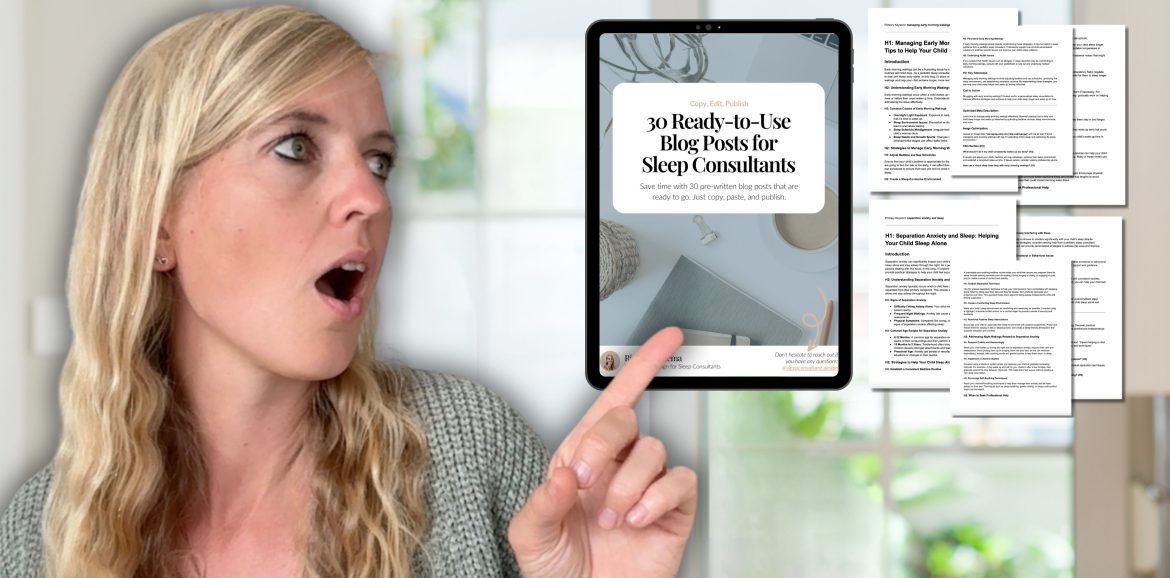There are plenty of benefits to blogging — it helps drive traffic to your website, it builds credibility and authority in your niche, it keeps your audience engaged with valuable content, and it improves your website’s SEO, helping you rank higher in search results over time. In this article I explain a blog content outline that will help you create blogs that not only offer high-quality, actionable advice but also have the potential to rank well on Google, bringing more traffic to your site over time!
Or you can fast-track and save hours with my 30x pre-written blog posts – ready to publish instantly.
1. Headline
- Length: Keep it between 55-70 characters.
- Guidelines: Use your primary keyword in the headline. Make it specific, actionable, and engaging. Example: “How to Help Your Child Fall Asleep Independently: Proven Tips for Exhausted Parents.”
- SEO Tip: Include power words (e.g., Proven, Easy, Effective) to increase click-through rates.
2. Introduction (100-150 words)
- Purpose: Capture attention and outline what the reader will gain from the post.
- Structure:
- Identify the pain point: Start by empathizing with the reader’s problem (e.g., “Are you struggling to get your child to sleep through the night without constant wake-ups?”).
- Tease the solution: Mention briefly that you’ll provide actionable steps and strategies in the post.
- Include your primary keyword naturally early in the introduction.
- SEO Tip: Keep the introduction concise, use keywords naturally, and set up reader expectations.
3. Subheadings (H2 & H3 Tags)
- Purpose: Improve readability and SEO by breaking down content into digestible sections.
- Guidelines:
- Use your primary keyword in at least one H2 subheading.
- Use related keywords and long-tail variations in other subheadings.
- Example Subheadings:
- “Why Your Child Struggles to Fall Asleep Alone” (H2)
- “The Importance of Consistency in Bedtime Routines” (H2)
- “Step-by-Step Plan to Teach Independent Sleep” (H2)
- SEO Tip: Use H2 and H3 tags strategically for keyword optimization and hierarchy, making the content easier for Google to understand.
4. Body Content (800-1500 words)
- Purpose: Deliver on the promise of your headline with actionable, insightful content.
- Guidelines:
- Use Bullet Points and Lists: Break down information into steps or tips to increase readability (e.g., “5 Easy Steps to Implement Independent Sleep Techniques”).
- Provide Data/Studies: Link to reputable sources like medical journals or parenting experts to back up your claims, which builds authority and trust.
- Offer Practical Tips: Make the advice actionable and easy to implement (e.g., “Start with a consistent bedtime routine every night for a week…”).
- Use Internal Links: Link to other relevant articles on your site to keep readers engaged and improve SEO (e.g., link to a post on sleep regressions).
- Use External Links: Link to authoritative external sites to add value (e.g., reputable studies on children’s sleep patterns).
- SEO Tip: Keep paragraphs short (2-4 sentences) and use keywords naturally throughout the body. Focus on latent semantic indexing (LSI) keywords (related terms) to avoid keyword stuffing.
5. Key Takeaways/Conclusion (100-200 words)
- Purpose: Summarize the main points and reinforce the reader’s takeaways.
- Structure:
- Briefly recap the key points.
- Offer encouragement (e.g., “Remember, consistency is key, and with patience, your child will learn to sleep independently”).
- Include a call-to-action (CTA): Encourage the reader to apply what they’ve learned, subscribe to your newsletter, download a free guide, or book a consultation with you.
- SEO Tip: End with a CTA that links to a relevant page (e.g., “Download our Free Sleep Training Guide!”).
6. Call-to-Action (CTA)
- Purpose: Encourage further engagement with your business or content.
- Guidelines:
- Use buttons, banners, or text CTAs that stand out.
- Offer a valuable resource (e.g., free consultation, checklist, guide).
- SEO Tip: Include a link to a relevant service page or opt-in offer to guide readers further down your sales funnel.
7. Optimized Meta Description (150-160 characters)
- Purpose: Provide a compelling summary for search engines and readers.
- Guidelines: Write a brief description including your primary keyword and a call-to-action.
- Example: “Learn how to teach your child to sleep independently with our proven methods and expert tips. Start your journey to better sleep today!”
8. Image Optimization
- Purpose: Improve SEO and visual engagement.
- Guidelines:
- Use at least one high-quality image with a descriptive file name (e.g., “child-sleeping-peacefully.jpg”).
- Use alt text to describe the image and include your keyword (e.g., “Child sleeping soundly through the night after using sleep training techniques”).
- SEO Tip: Compress images to ensure fast loading times, as site speed affects rankings.
9. Frequently Asked Questions (FAQ Section)
- Purpose: Improve SEO by answering common queries and targeting voice search.
- Guidelines:
- Answer 2-3 relevant questions that parents might ask (e.g., “What age should I start sleep training?”).
- Write answers in conversational language to appeal to search engines’ featured snippet algorithms.
- SEO Tip: Use question-based headings for better ranking in Google’s “People also ask” section.
Additional SEO Tips:
- Keyword Research: Use tools like Google Keyword Planner, Ubersuggest, or SEMrush to identify high-traffic keywords relevant to your topic.
- Mobile Optimization: Ensure your blog is mobile-friendly, as this is a ranking factor for Google.
- Content-Length: Aim for a blog post length between 800-1500 words, as longer, well-researched content often ranks better.
- User Engagement: Focus on writing content that encourages comments, shares, and longer time-on-page metrics to improve SEO.
Now you know all of this, you can either write your own blogs from scratch, or… take the fast-track and save hours with my 30 pre-written, ready-to-publish blog posts.




